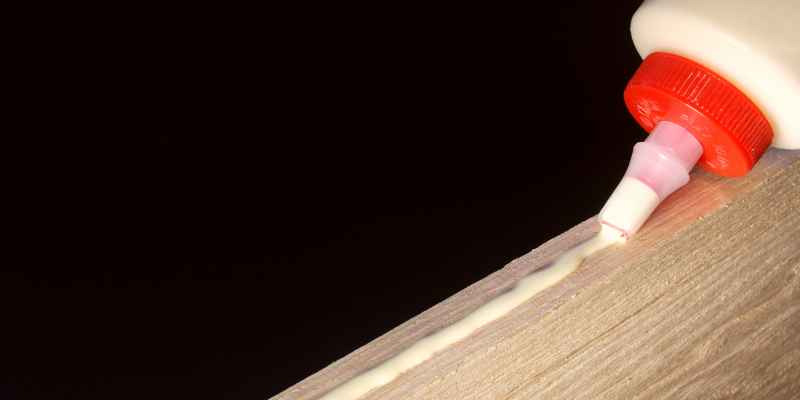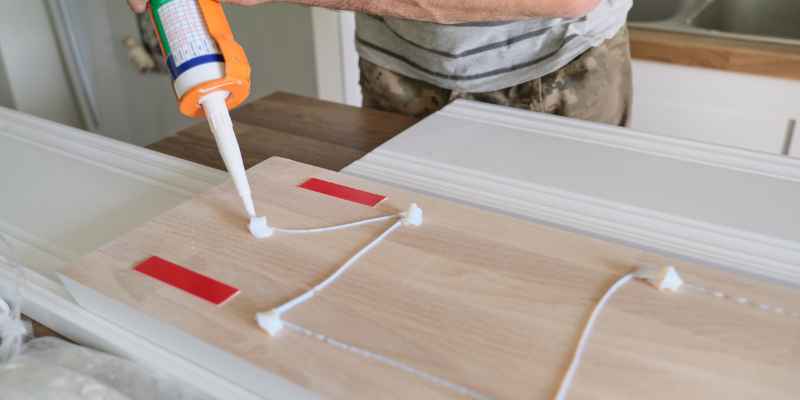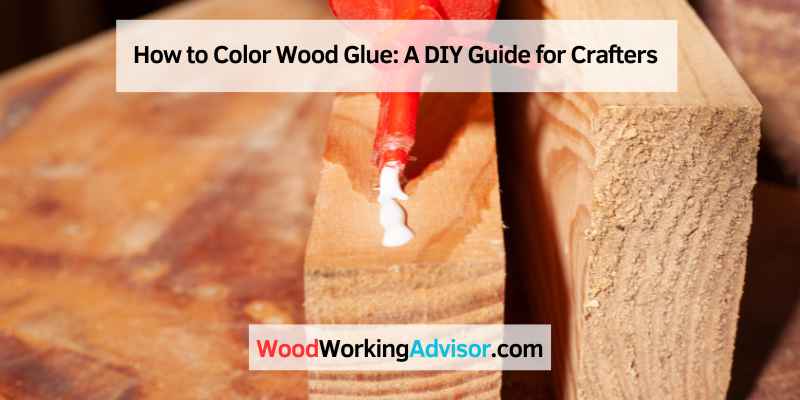To color wood glue, add a small amount of acrylic paint or wood dye until desired color is achieved. Mix thoroughly.
Wood glue is a versatile adhesive used in woodworking projects for bonding wood pieces together. While typically available in its natural color, you may want to color it for aesthetic reasons or to match the wood you are working with.
Adding color to wood glue is a simple process that can enhance the overall look of your project. In this blog post, we will explore the steps to effectively color wood glue, providing you with tips and tricks to achieve the desired results. Whether you are a seasoned woodworker or a DIY enthusiast, coloring wood glue can add a unique touch to your creations. Let’s delve into the world of coloring wood glue and unleash your creativity!
Introduction To Coloring Wood Glue
Coloring wood glue is a simple process that can add a unique touch to your woodworking projects. By mixing in a small amount of pigment or dye, you can achieve a wide range of colors and create stunning effects. Whether you want to match the color of the wood or add a pop of contrast, coloring wood glue is a fun and creative way to enhance your craftsmanship.
Woodworking is an art that requires precision and attention to detail. One of the essential elements of woodworking is the adhesive that holds the pieces of wood together. Wood glue is a popular adhesive used by woodworkers. It is strong, durable, and easy to use. However, wood glue is typically white or yellow, which can be unappealing when it comes to the final appearance of the project.
This is where coloring wood glue comes in. By adding color to the glue, woodworkers can achieve a seamless finish and elevate the overall look of the project. In this article, we’ll explore why you should consider coloring your wood glue and the benefits it offers to crafters.
Why Color Wood Glue?
Wood glue is typically white or yellow, which can be a problem when working on projects that require a seamless finish. The color of the glue can be visible in the gaps between the wood pieces, which can ruin the final look of the project. By coloring wood glue, you can match the color of the glue to the wood or stain you’re using, creating a seamless finish that looks professional.
Benefits For Crafters
Coloring wood glue has several benefits for crafters. First, it allows you to achieve a seamless finish, which can make your project look more professional. Second, it gives you more control over the final appearance of the project. By matching the color of the glue to the wood or stain you’re using, you can create a cohesive look that ties the project together. Finally, coloring wood glue is a fun and creative way to add a personal touch to your project. You can experiment with different colors and techniques to create a unique look that reflects your style and personality.
Overall, coloring wood glue is a simple and effective way to elevate the look of your woodworking projects. By matching the color of the glue to the wood or stain you’re using, you can achieve a seamless finish that looks professional and polished. Plus, it’s a fun and creative way to add a personal touch to your projects.
Types Of Wood Glue Suitable For Coloring
When it comes to woodworking projects, using colored wood glue can add a unique and personalized touch to your creations. However, not all types of wood glue are suitable for coloring. Understanding the different types of wood glue that can be colored will help you choose the right one for your project.
Pva Glues
PVA (Polyvinyl Acetate) glues, also known as white or yellow glues, are water-based adhesives commonly used in woodworking. These glues are suitable for coloring due to their porous nature, which allows them to absorb pigments effectively. When using PVA glues for coloring, it is important to select a dye or pigment that is compatible with water-based solutions to achieve the desired color intensity.
Epoxy Resins
Epoxy resins are a type of adhesive that consists of a resin and a hardener. While epoxy resins are not as porous as PVA glues, they can still be colored using specially formulated epoxy tints or pigments. These tints are designed to be mixed with the epoxy resin and hardener, allowing for a wide range of color options. It is important to follow the manufacturer’s instructions when coloring epoxy resins to ensure proper mixing and curing.
Selecting The Right Pigments
When it comes to coloring wood glue, selecting the right pigments is crucial for achieving the desired results. Natural and synthetic pigments offer different benefits and considerations. Safety is also a key factor when working with pigments, as some may pose health risks if not handled properly.
Natural Vs. Synthetic Pigments
Natural pigments are derived from sources such as plants, minerals, and animals. They offer earthy tones and are often favored for their organic appeal. On the other hand, synthetic pigments are artificially created and provide a wide range of vibrant colors. They are known for their consistency and durability.
Safety Considerations
When working with pigments for coloring wood glue, it’s essential to prioritize safety. Some pigments may contain hazardous materials that can pose health risks if proper precautions are not taken. Always wear protective gear such as gloves and a mask when handling pigments, and ensure adequate ventilation in the workspace.
Preparation Steps

Before you start coloring wood glue, it’s essential to follow a few preparation steps to ensure the best results. By gathering the necessary materials and taking safety measures, you can proceed with confidence and achieve a beautiful colored wood glue finish.
Gathering Materials
Before you begin coloring wood glue, make sure you have the following materials handy:
- A container of wood glue
- A coloring agent (such as powdered pigment or liquid dye)
- A mixing container or palette
- A stirring tool (such as a wooden stick or palette knife)
- Protective gloves
- Protective eyewear
Safety Measures
When working with wood glue and coloring agents, it’s important to prioritize safety. Follow these safety measures to protect yourself and ensure a safe working environment:
- Wear protective gloves to prevent direct contact between the coloring agent and your skin.
- Put on protective eyewear to shield your eyes from any potential splashes or spills.
- Work in a well-ventilated area or use a respirator to avoid inhaling any fumes.
- Read and follow the manufacturer’s instructions and warnings on the wood glue and coloring agent packaging.
- Keep the work area clean and organized to minimize the risk of accidents.
By gathering the necessary materials and taking safety measures, you are now ready to dive into the process of coloring wood glue. These preparation steps will ensure that you have everything you need and can work safely and efficiently.
Mixing Techniques
When it comes to coloring wood glue, mixing techniques play a crucial role in achieving the desired results. By mastering the art of combining pigments and dyes with wood glue, you can create custom hues to complement your woodworking projects. In this post, we’ll explore the various mixing techniques that can help you achieve vibrant and uniform colors for your wood glue.
Achieving The Desired Hue
To achieve the desired hue in your colored wood glue, start by selecting the appropriate pigments or dyes. These can include universal colorants, powdered pigments, or liquid dyes. Begin with a small amount and gradually add more until you achieve the color intensity you desire. Remember to mix the pigments or dyes thoroughly to ensure a consistent hue throughout the glue.
Ensuring Uniform Color
Ensuring uniform color in your wood glue involves meticulous mixing and testing. One method is to create a color sample by mixing the pigments or dyes with a small amount of wood glue. This allows you to assess the final color before committing to the entire batch. Additionally, using a consistent mixing technique, such as stirring in a circular motion, can help distribute the colorants evenly.
Application Tips
Enhance your woodworking projects by learning how to color wood glue effectively. Mix in small amounts of wood stain to the glue for a custom color match, ensuring seamless and professional-looking results. Achieve a flawless finish by applying the colored wood glue with precision and care.
Surface Preparation
Before applying colored wood glue, ensure the surface is clean and dry.
Sand the wood to create a smooth surface for optimal adhesion.
Applying Colored Glue
Choose a color that complements or contrasts with the wood for desired effect.
- Squeeze a small amount of colored glue onto the surface.
- Spread it evenly using a brush or applicator.
- Wipe off excess glue with a damp cloth before it dries.
Drying And Curing
When coloring wood glue, understanding the Drying and Curing process is crucial. Let’s explore the Drying Times and Curing Conditions in detail.
Drying Times
- Depends on humidity and temperature
- Average drying time is 30 minutes to 1 hour
Curing Conditions
| Conditions | Optimal |
|---|---|
| Temperature | Around 70°F |
| Humidity | Around 50% |
Finishing Touches
When it comes to coloring wood glue, the finishing touches are crucial. Sanding and Polishing and Protective Coatings play a key role in achieving a professional look.
Sanding And Polishing
- Sand the wood surface until smooth.
- Use fine-grit sandpaper for a polished finish.
- Polish the wood with a soft cloth.
Protective Coatings
- Apply a layer of clear varnish for protection.
- Consider using polyurethane for added durability.
- Allow the coating to dry completely before handling.
Creative Projects With Colored Wood Glue
Decorative Inlays
Enhance your woodworking projects with vibrant colored wood glue for eye-catching decorative inlays.
Custom Furniture Accents
Transform ordinary furniture into unique pieces by incorporating colored wood glue for custom accents.
Troubleshooting Common Issues
Color Fading
If you notice color fading on your colored wood glue, it could be due to exposure to direct sunlight or harsh environmental conditions. To prevent this, store your colored wood glue in a cool, dark place away from sunlight and extreme temperatures. Additionally, using a UV-resistant topcoat can help prolong the color intensity and prevent fading.
Uneven Application
Uneven application of colored wood glue can result in patchy or streaky finishes. To avoid this issue, ensure that the wood surface is clean and free of dust before applying the colored glue. Use a brush or applicator to apply the glue evenly, following the wood grain for a smooth and consistent finish. If you encounter uneven coloring, gently sand the surface and reapply the colored glue for a more uniform appearance.

Frequently Asked Questions
Q: Can I Add Food Coloring To Wood Glue?
A: Yes, you can add food coloring to wood glue to achieve your desired color. However, keep in mind that too much food coloring may affect the glue’s bonding strength.
Q: How Do I Mix Color With Wood Glue?
A: To mix color with wood glue, add a few drops of food coloring to the glue and mix thoroughly. Test the color on a scrap piece of wood to ensure the desired shade is achieved before applying.
Q: Can I Use Paint To Color Wood Glue?
A: Yes, you can use paint to color wood glue. Simply mix a small amount of paint into the glue until the desired color is achieved. Keep in mind that too much paint may affect the glue’s bonding strength.
Q: Is It Necessary To Color Wood Glue?
A: No, it is not necessary to color wood glue. However, coloring the glue can help camouflage it and make it less noticeable on the wood surface.
Conclusion
To conclude, coloring wood glue is a simple yet effective way to enhance the aesthetic appeal of your woodworking projects. By following the steps outlined in this blog post, you can easily transform ordinary wood glue into a vibrant and eye-catching adhesive.
Whether you’re looking to add a pop of color or create intricate designs, coloring wood glue gives you the freedom to unleash your creativity. So go ahead, experiment with different dyes and pigments, and elevate your woodworking projects to new levels of beauty.
Happy crafting!


